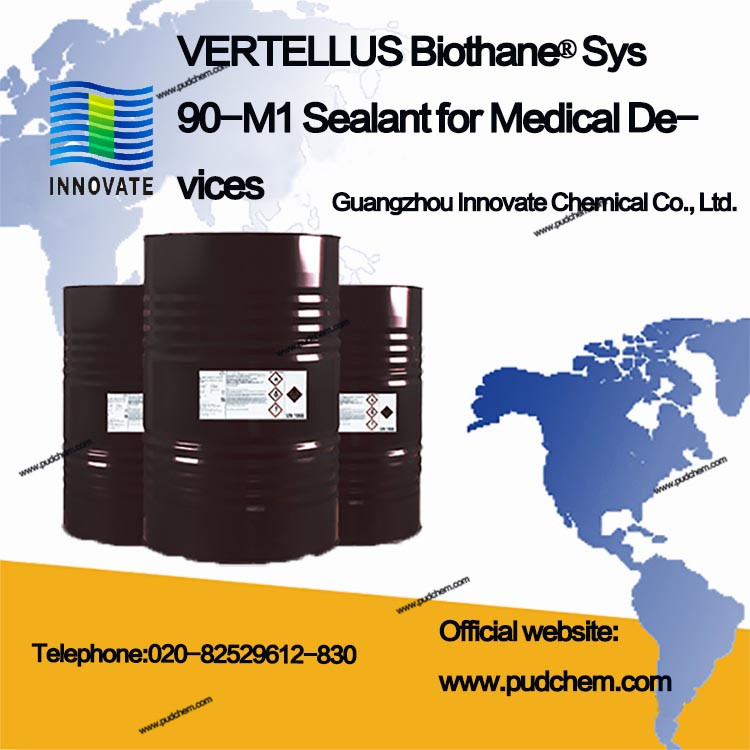VERTELLUS Biothane® Sys 90-M1 Sealant for Medical Devices

Product introduction
Biothane® Sys 90-M1 is a two-component polyurethane liquid casting sealant based on ricinoleate. It has excellent mechanical properties and high impact strength with a Shore hardness of 70D. The system contains no TDI, aromatic amines or non-reactive diluents. It can be used for cylindrical filters such as dialyzers, as well as sealing of medical equipment.
Features
· Resistant to germicidal conditions
Excellent wetting and adhesion to various substrates
· Excellent strength and mechanical properties
· Outstanding hydrolytic stability
· Low shrinkage
application
★ As a sealant for cartridge filters: hemodialyzers, oxygen injectors, blood concentrators, bioreactors, water purifiers, etc.; and medical equipment: heat exchangers, cardiac arresters, neuromodulation, guide Urinary tube etc.
★ As a binder for membrane materials: cellulose, polysulfone, polyacrylonitrile, polyethersulfone, polypropylene, etc.
★ As a coating for substrates: polycarbonate, polyester, stainless steel, etc.
Processing characteristics
Biothane® Sys 90-M1 is a two-component sealant. The polyurethane prepolymer component Vorite® 689 and the polyol component Polycin® 640-M1 need to be mixed during processing. The ratio and mixing parameters are shown in the table below.
|
characteristic |
Typical value |
testing method |
|
mixing ratio |
55/45 weight ratio; |
- |
|
Mixed Viscosity@25℃ |
2500 cP |
ASTM D4889 |
|
Gel time (dry stick, 100g, 25℃) |
85 min |
CC 410 |
|
Peak exotherm (mass=100g) |
45℃ |
ASTM D2471 |
Recommended firmware
The sealant will fully cure in about a week at room temperature. If accelerated curing is required, full cure is possible in 24 hours at 60°C or 6 hours at 80°C.
Ingredient properties
Vorite® 689 is a polyurethane prepolymer, which can improve the safety and control of the reaction in the process. It is resistant to moisture and freezing, and can be designed with different process viscosities; Polycin® 640-M1 is a polyol component, containing catalyst. These two are used as the two components of Biothane® Sys 90-M1 sealant before mixing, and their physical parameters are as follows.
|
|
Typical @25°C |
||
|
Attributes |
Vorite® 689 |
Polycin® 640-M1 |
testing method |
|
Viscosity (cP) |
11,000 |
650 |
ASTM D4889 |
|
proportion |
1.17 |
0.97 |
ASTM D1875 |
|
Pour point (℃) |
-7 |
-21 |
CC 453 |
|
Flash point (℃) |
230 |
220 |
ASTM D3828 |
|
Exterior |
clear amber |
clear amber |
Visually |
Physical Properties (Sealant)
|
characteristic |
Typical value |
testing method |
|
Hardness (Shore D) |
70 |
ASTM D2240 |
|
proportion |
1.1 |
ASTM D752 |
|
Linear shrinkage (%) |
0.8 |
ASTM C531 |
|
Tensile Strength at Break (psi) |
3000 |
ASTM D638 |
|
Tensile Strength at Yield (psi) |
5000 |
ASTM D638 |
|
Elongation(%) |
150 |
ASTM D638 |
|
Tear strength (pli) |
900 |
ASTM D624 |
|
color |
clear light amber |
Visually |
|
Cytotoxicity |
No cytolysis or toxicity |
ISO 10993 |
|
hemolysis |
non-hemolytic |
ISO 10993 |
Dielectric properties (sealant)
|
characteristic |
Typical value |
testing method |
|
Volume resistivity (Ω·cm) |
1.5 x 1015 |
ASTM D257 |
|
Dielectric Constant (kHz) |
2.9 |
ASTM D150 |
|
Dissipation Factor (kHz) |
0.03 |
ASTM D150 |
|
Dielectric Strength (V/mil) |
650 |
ASTM D149 |
|
Insulation resistance (Ω) |
>1015 |
Telcordia MS17000 |
Toxicity, Handling and Storage 
Generally, isocyanates are locally irritating to the skin, eyes and respiratory tract. When inhaled, they may damage the mucous membranes. Although Vorite 689 is a low vapor pressure isocyanate based non-TDI prepolymer, however, proper handling precautions should be strictly followed when large quantities of prepolymer are used. This includes proper ventilation and the use of safety goggles, gloves and an apron. In case of skin contact, remove it and rinse immediately with plenty of soap and water. Any spills should be covered with wood chips and treated with a dilute aqueous solution of ammonia or ethanol (or methanol) and water before disposal.
Vorite 689 should be stored at temperatures above 15°C (60°F). Crystals may form or freeze if the product is exposed to temperatures below this temperature for extended periods of time. If this happens, melt it by heating to 65°C (150°F) for 1 hour, then stir well. This operation can only be performed once. If the product has been frozen more than once, it should be discarded.
For Vorite 689 and Polycin 640-M1, exposure to moisture should be minimized. It should be stored in an airtight container covered with dry air or dry inert gas after each use.
The above information is only a brief overview and is not necessarily complete. The latest MSDS should be pre-read before using this material.
More about this source textSource text required for additional translation information
Send feedback
- PREV:VERTELLUS Biothane® product range Sealants for the medical industry
- NEXT:Perstorp Capa 7201A modified polycaprolactone polyol





















